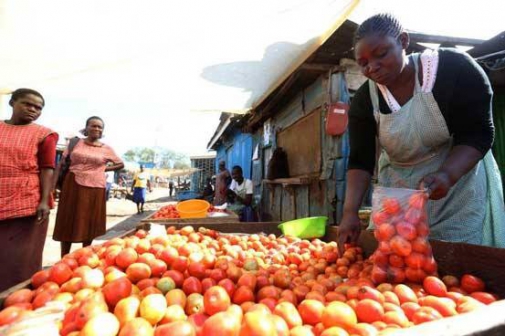The four-day violent protests that followed the declaration of the presidential election results brought Kisumu County almost to its knees economically and revealed the lakeside town’s inability to feed itself. During the protests, which left four dead and scores injured, all roads leading to the town were barricaded, locking out trade with neighboring Kisii, Nandi, Kericho and Nyamira counties. As a result of the lock-down, Kenya’s third largest city, which relies heavily on supplies from outside the county to feed its population of nearly half a million people, soon ran out of food. With supermarkets also closed after running out of fast-moving commodities and out of fear of attacks by protesters, food became scarce and pricey. A single tomato cost as high as Sh25 while a few withered leaves of kale (sukuma wiki) fetched anything between Sh50 and Sh100. The same was the case for other groceries. The crisis trickled all the way down to rural farmlands – where one would expect abundance – revealing a crisis that has attracted a lot of attention.
From fish, vegetables and bananas to eggs, chicken and fruits, Kisumu relies on its neighbours for virtually everything. Milk, onions, garlic, capsicum, broccoli, tomatoes and lettuce come from Nandi and Kericho counties, while eggs and bananas are brought by lorry from as far as Uganda. With Lake Victoria fish stocks dwindling, Chinese tilapia has flooded the Kisumu markets since March 2016. Smoked and dried fish, which are almost always available, come from Turkana County, further consigning Kisumu to the rather uncomfortable position of a consumer county despite having a fresh water lake, permanent rivers and ample farmlands. At the Jubilee fresh produce market, watermelons and red peppers, sold by Daniel Oyoko, are grown under irrigation in Ahero. But even these foods flood the market from Marigat in Baringo County. Slow-moving rice from Ahero Irrigation Scheme is also sold but traders say it can hardly compete with varieties from Tanzania.
Agriculture, Livestock and Fisheries Executive Henry Obade admits there is a shortage of agricultural production, and that is why most of the food eaten in Kisumu comes from outside the county. Almost negligible
What is produced within is almost negligible. The city’s population is always rising and the presence of cross-border products is testimony to this assertion,” he said. Kisumu needs 80 million litres of milk annually, according to statistics from the Department of Agriculture. But the area produces only 26 million litres yearly; the deficit has created a huge market for milk from Nandi and Kericho. The region produced only 693,000 metric tonnes of maize in 2015, which was not enough to feed its entire population. “We need about 1.8 million metric tonnes of maize annually to feed residents, but we have failed to meet the target because of fluctuating rainfall. Unless drastic measures are drawn, our food basket will soon be depleted,” said Mr Obade.
‘We have a big problem when it comes to vegetable production yet we consume a lot. It is of great concern that farmers and traders buy a crate of tomatoes from Kisii for about Sh5,000 and when they transport it to Kisumu, the price is even higher.” Obade revealed that in the past financial year, the county allocated Sh170 million towards development of the agricultural sector in a bid to improve food security. “To address food insecurity, we are working to rehabilitate moribund irrigation schemes. We have already started on Gem-Rae and Kabonyo Kanyakwan rice schemes in Nyakach,” he said. Kisumu Business Coalition Chairman Israel Agina said over-dependence on cash crops such as rice and sugarcane, whose fortunes have dwindled, was the root cause of the food shortage.
Source; The Standard Digital.

